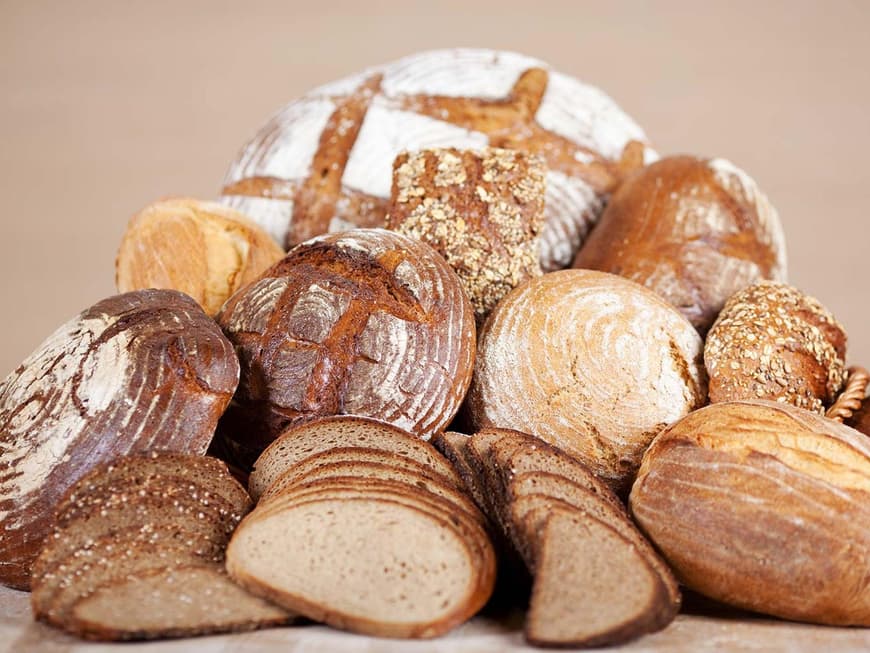
Advantages of bread without flour
White flour causes blood sugar levels to rise quickly, which is why wholemeal breads or flourless bread are more beneficial. They are an excellent alternative for people who have a gluten intolerance. Substitutes include almond flour, coconut flour or lupin flour. However, as shown in the recipe below, in many cases no substitute flour is used, only rolled oats (and other flakes such as millet flakes), quinoa, seeds, seeds or nuts. Water and fat are important for bread without flour to hold together - they are practically the glue. For many people, however, it is also important that the bread looks and tastes similar to "real" bread.
You can modify or spice up the taste of this type of bread by adding raisins, cranberries or other dried fruit as well as various nuts and the like. Popular banana breads, for example, can be made with fresh bananas and almonds - so you can also avoid flour with these low carb breads. If you live a healthy lifestyle, bread without flour is definitely a regular item on the table, as nutrients and minerals are provided by the other ingredients. The rich bread is also very filling.
However, because it contains no flour, this bread does not necessarily have fewer calories, i.e. less energy, than conventional types of bread: seeds, kernels and nuts contain a lot of fat, but this is nutritionally valuable - hence the term healthy fats. Bread without flour can form mold more quickly, which is why it makes sense to store it in the fridge. It will keep there for a few days.
Nut bread and energy bread in one: bread recipe tip from blogger Sarah Britton:
Bread without flour - the recipe for the bread dough
Ingredients:
- 135 g sunflower seeds
- 90 g linseed
- 65 g hazelnuts, almonds or other nuts
- 145 g gluten-free oat or spelt flakes
- 2 tsp chia seeds
- 4 tsp psyllium husks
- 1 tsp fine sea salt
- 1 tsp maple syrup, agave syrup or honey
- 3 tsp melted coconut oil or clarified butter (ghee)
- 350 ml water
Preparation:
- Place the ingredients in a bowl and mix together. Melt the coconut oil in a pan on the stove and add the maple syrup and sea salt.
- Add the oil mixture to the other ingredients in the bowl. Gradually pour in the water and mix everything together.
- Line a loaf tin with baking paper and press the dough into it (preferably with a spoon). Smooth out the dough and leave to rise for at least 3 hours.
- Preheat the oven to 180 degrees and bake the bread without flour for 20 minutes on the middle shelf. Carefully turn the bread out onto a wire rack, put it back in the oven on a baking tray and bake for a further 40 minutes. The bread is ready when the crust sounds hollow when tapped.
Tip: When baking bread, it is always best to bake two loaves at the same time, as this is the most economical. You can then simply freeze the second loaf - please allow it to cool completely first! If you are vegan, a flourless bread recipe is also suitable.
Is there a recipe for flourless bread for someone with a nut allergy?
It's very simple: if you have a nut allergy, use more pumpkin seeds instead of the nuts listed in the recipe, for example. Otherwise, simply try this vegan recipe:
Ingredients:
- 300 g rolled oats
- 250 g sunflower seeds
- 200 g linseed (whole or crushed)
- 50 g psyllium husks
- 25 g chia seeds
- 50 g sesame seeds
- 50 g pumpkin seeds
- 2 teaspoons salt
- 2 tablespoons agave syrup
- (or rice syrup)
- 6 tablespoons neutral rapeseed oil or neutral sunflower oil
Preparation:
- Preheat oven to 155 degrees top/bottom heat or 175 degrees fan.
- Line a baking tin (30 cm) with baking paper.
- Mix the dry ingredients and grind or crush.
- Knead together with the remaining ingredients, pour the dough into the baking tin and bake the bread in the middle of the oven for approx. 35 minutes. Turn the bread out and bake, bottom side up, for a further 40 minutes without the tin.
